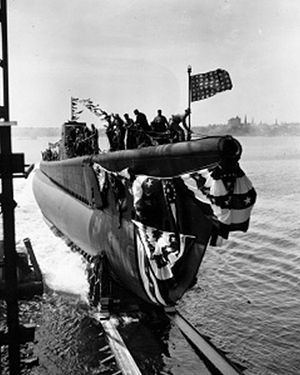Laid down 21 September 1942 Commissioned 6 August 1943 Launched 9 May 1943 | Sponsored by Mrs. R. W. Christie Construction started 21 September 1942 Length 95 m | |
 | ||
Displacement 1,525 long tons (1,549 t) surfaced2,424 long tons (2,463 t) submerged Builder General Dynamics Electric Boat | ||
USS Corvina (SS-226), a Gato-class submarine, was the only ship of the United States Navy to be named for the corvina, any of various important food fishes related to the weakfish and the croaker of the Atlantic coast.
Contents
Her keel was laid down by the Electric Boat Company of Groton, Connecticut on 21 September 1942. She was launched on 9 May 1943 (sponsored by Mrs. LaRene P. Christie, wife of Rear Admiral Ralph. W. Christie, commander of submarine operations in Fremantle, Australia), and commissioned on 6 August 1943 with Commander Roderick S. Rooney (Class of 1929) in command.
Service record
Clearing New London, Connecticut, on 18 September 1943, Corvina arrived at Pearl Harbor on 14 October. She put out from Pearl Harbor on her maiden war patrol 4 November, topped off her fuel tanks at Johnston Island two days later, and was never heard from again.
Her assignment had been a dangerous one: to patrol as closely as possible to the heavily guarded stronghold of Truk and to intercept any Japanese sortie endangering the forthcoming American invasion of the Gilbert Islands. Japanese records report that Japanese submarine I-176 launched three torpedoes at an enemy submarine south of Truk on 16 November, claiming two hits which resulted in the explosion of the target. Her loss with her crew of 82 was announced 14 March 1944, making Corvina the only American submarine to be sunk by a Japanese submarine in the entire war.
In popular culture
The loss of the Corvina is referenced in the 1951 John Wayne film Operation Pacific. In the film, the fictitious Gato-class sub USS Thunderfish makes an impromptu rendezvous with the Corvina after the Corvina had reported problems on Number 1 Main Engine. The subs exchange engine parts and the captains also exchange films, John Wayne offering George Washington Slept Here, and the Corvina's captain offering "a submarine picture", later revealed to be the 1943 film Destination Tokyo. Later, while the crew of the Thunderfish are watching Destination Tokyo, John Wayne is shown trying to figure out torpedo explosions reported by the sub's sonar operator. The following day, the Thunderfish comes across wreckage, and discovers the case containing George Washington Slept Here, revealing that the Corvina had been sunk. The Thunderfish's radar then reports a single contact, and the sub submerges. John Wayne discovers "one I-type Jap submarine" while looking through the periscope. The Thunderfish then engages, torpedoes, and sinks the Japanese sub, avenging the loss of the Corvina.
